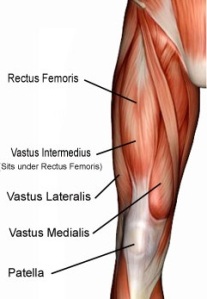The Centeno-Schultz Clinic offers PRP, prolotherapy and bone marrow and platelet derived stem cell therapies. An understanding to function and stability is essential and is covered in Ortho 2.0. Direct visualization using MSK ultrasound or x-ray is our standard to ensure accurate placement and to avoid the complications associated with blind knee injections.
Muscle and tendon function is critical to the knee joint health. A brief review of the anterior compartment is helpful.
The quadriceps is a group of large muscles in the front of the thigh. It consists of four major muscles:
 Rectus femoris: A large muscle that covers most of the other, deeper quadriceps muscles.
Rectus femoris: A large muscle that covers most of the other, deeper quadriceps muscles.
Vastus lateralis
Vastus intermedius
Vastus medius
A tendon is a fibrous band of connective tissue that connects the muscle to the bone. The quadriceps tendon attaches the quadriceps muscles to the patella.
Quadriceps control knee extension and stabilize the kneecap (patella).
Pain can arise from the quadriceps tendon due to inflammation, chronic degeneration or tear. A tear can be either partial or complete and is usually the result of trauma. Tendon weakness predisposes to tears. Conditions that can lead to tendon weakness include quadriceps tendonitis, chronic diseases, steroid use, immobilization and the use of a class of antibiotics called fluoroquinolones.









